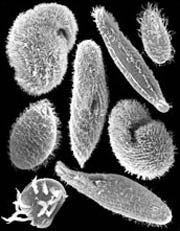Biodiversity Depends on Historical Plant and Animal Relationships

The experiment using microorganisms including the ciliates shown here indicates that historical events produce a remarkable variety of productivity-biodiversity relationships--a finding that would be difficult to reveal in natural ecosystems composed of large, slowly responding macroorganisms. <br> <br>Photo Credit: Wilhelm Foissner, Andreas Zankl, University of Salzburg, Austria
Some thirty million species now live on Earth, but their spatial distribution is highly uneven. Biologists since Darwin have been asking why. Now, scientists funded by the National Science Foundation (NSF), have discovered part of the answer: how plant and animal communities originally assembled is a predictor of future biodiversity and ecosystem productivity.
“Despite its importance, species diversity has proven difficult to understand, in large part because multiple processes operating at various scales interact to influence diversity patterns,” said biologist Tadashi Fukami of the University of Tennessee at Knoxville, lead author of a paper on the subject published in the July 24th issue of the journal Nature. “On evolutionary scales, species diversity is a result of speciation and extinction. But evolutionary processes are variable across space, interactive over time, and consequently, hard to identify. On ecological scales, diversity is a result of community assembly, how species join ecological communities over time.”
Fukami and co-author Peter Morin of Rutgers University in New Jersey attempt to provide a novel ecological perspective from which to view diversity patterns. They argue that we can better understand diversity by considering how the history of community assembly interacts with other ecological variables to affect diversity.
Their paper addresses a topic of central importance in ecology, specifically the cause of different relationships between productivity and biodiversity observed in natural ecosystems. Ecologists define productivity broadly as the amount of energy available for ecosystem development in a given location. In this experiment, productivity was manipulated by changing the nutrient concentration of growth medium in ecological communities of microorganisms housed in a laboratory.
“Fukami and Morin’s study adds an important, new piece to the ecological puzzle that relates ecosystem productivity to species diversity,” said Saran Twombly, program director in NSF’s division of environmental biology. “The sequence of species used to create a community has a large effect on the productivity-diversity relationship. This novel result contributes substantially to our understanding of community ecology.”
We know that the relationship between productivity and biodiversity takes various forms in nature, presenting a difficult challenge in understanding biodiversity patterns, said Fukami. “Using a rigorous experimental approach, we show in this paper that productivity-biodiversity relationships depend critically on the history of community assembly, in particular on the specific sequence of species arrival from a regional pool of colonists.” The results argue that community assembly processes must be considered along with resource use, disturbance, and other factors that determine the ultimate form of productivity-diversity relationships. A key point is that these fundamental patterns are unlikely to have a single common explanation. Although this study was not based on a particular ecosystem, the study shows that historical effects are possible and may explain patterns observed in ecosystems.
These findings will be of broad interest to ecologists, environmental scientists, ecological economists, and others interested in the causes of biodiversity patterns, Fukami believes. “Scientific understanding of how biodiversity responds to productivity is important to the conservation and management of natural ecosystems that are experiencing nutrient enrichment by human activities [such as increased input of phosphorus and nitrogen into lakes, ponds, and estuaries],” said Fukami.
Media Contact
All latest news from the category: Life Sciences and Chemistry
Articles and reports from the Life Sciences and chemistry area deal with applied and basic research into modern biology, chemistry and human medicine.
Valuable information can be found on a range of life sciences fields including bacteriology, biochemistry, bionics, bioinformatics, biophysics, biotechnology, genetics, geobotany, human biology, marine biology, microbiology, molecular biology, cellular biology, zoology, bioinorganic chemistry, microchemistry and environmental chemistry.
Newest articles

Superradiant atoms could push the boundaries of how precisely time can be measured
Superradiant atoms can help us measure time more precisely than ever. In a new study, researchers from the University of Copenhagen present a new method for measuring the time interval,…

Ion thermoelectric conversion devices for near room temperature
The electrode sheet of the thermoelectric device consists of ionic hydrogel, which is sandwiched between the electrodes to form, and the Prussian blue on the electrode undergoes a redox reaction…

Zap Energy achieves 37-million-degree temperatures in a compact device
New publication reports record electron temperatures for a small-scale, sheared-flow-stabilized Z-pinch fusion device. In the nine decades since humans first produced fusion reactions, only a few fusion technologies have demonstrated…





















